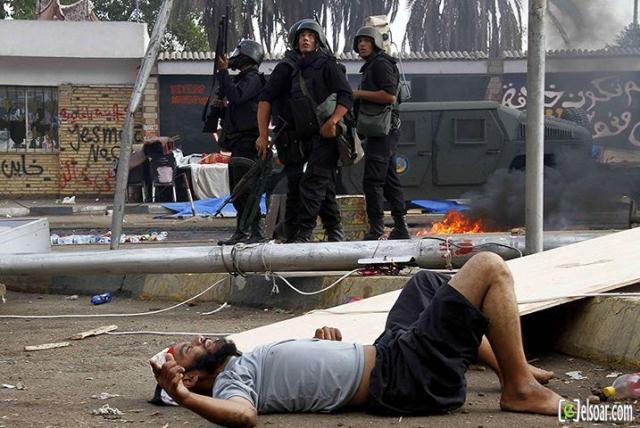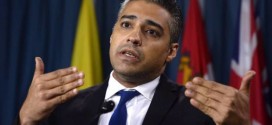By Kenneth Roth
Some combination of denial and fear led the Egyptian government to refuse my colleague and me entrance to the country on Sunday night. The form wrapped around my colleague's passport describing why we were being denied entry was checked, "For security reasons."
I went to Cairo to present Egypt's leaders with evidence that police slaughtered 1,000 people at Rabaa Square. They wouldn't even let me out of the airport.
It was an unprecedented step. No one from Human Rights Watch had ever been barred from Egypt, even during the darkest days of former President Hosni Mubarak's rule. But the reason for my visit was also unprecedented -- a massacre that rivals the most notorious of recent times, such as China's Tiananmen killings in 1989 and Uzbekistan's Andijan slaughter in 2005.

I came to Cairo to present the results of a detailed investigation that Human Rights Watch had conducted into last year's massacre by Egyptian security forces of protesters at a large sit-in demonstration in Cairo's Rabaa Square, which was organized to oppose the military's ouster of the Muslim Brotherhood's Mohamed Morsi, Egypt's first elected civilian president. In one day – indeed, some 12 hours – security forces killed at least 817 people, each individually identified by Human Rights Watch, and quite likely more than 1,000. The slaughter was so systematic that it probably amounts to a crime against humanity under international law.
There is every reason to believe that this was a planned operation implicating officials at the very top of the Egyptian government. Ken Roth, executive director
The sit-in had been underway for a month and a half when Egyptian authorities moved to quash it. Egyptian officials promised a gradual dispersal that would include warnings and a safe exit for anyone who chose to leave. The actual dispersal was anything but that. Early in the morning of Aug. 14, 2013, security forces launched their operation: Within minutes, security forces -- advancing on crowds of protesters with bulldozers, armed personnel carriers, and hundreds of ground forces -- were already firing live ammunition, sometimes in intense fusillades.
Protesters immediately began falling. The promised safe exits never materialized until the final minutes of the dispersal, causing protesters to cower in an ever shrinking area as snipers picked off people from rooftops and ground-level police fired indiscriminately into the crowd. Snipers even targeted the entrance to Rabaa Hospital, which became known as "Sniper's Alley."
The Egyptian government has been quick to stress that there was some violence among the demonstrators as well, but that does not begin to justify the security forces' slaughter. On the periphery of the demonstration, some young men did throw Molotov cocktails at security forces and, in a few instances, used firearms. However, the police found only 15 firearms among the tens of thousands of demonstrators, and the police death toll, according to the government's own Forensic Medical Authority, was eight. Such a grossly disproportionate death toll suggests something deeply wrong with this operation, especially as this was a policing operation in which international law requires that lethal force be used only if necessary to meet an imminent lethal threat.
Far from taking cover in fear of protester violence, the police stood openly on rooftops and armored personnel carriers as they fired and advanced on the protesters. Countless witnesses, including local residents and independent journalists, described anything but a targeted effort to neutralize a handful of armed protesters. Instead, they described security forces indiscriminately mowing down the demonstrators in Rabaa Square.
There is every reason to believe that this was a planned operation implicating officials at the very top of the Egyptian government. Interior Minister Mohamed Ibrahim was the lead architect of the dispersal plan. His immediate supervisor, in charge of all security operations, was Abdel Fattah al-Sisi, who was then defense minister and deputy prime minister for security affairs, and is now Egypt's president.
In discussions prior to the dispersal, senior Interior Ministry officials spoke of anticipating thousands of deaths. The day after the slaughter, Ibrahim said it had all gone exactly according to plan, and later gave bonuses to participants.
The Rabaa dispersal was part of a pattern of cases across Egypt in which security forces used excessive force, including killing 61 participants at a sit-in protest outside the Republican Guard headquarters on July 8, and another 95 protesters near the Manassa Memorial in eastern Cairo on July 27. There was every reason for senior officials to take steps to prevent the large-scale killing of protesters in the Rabaa Square dispersal, but there is no evidence that they did.
Despite calming reassurances that the security forces would exercise restraint, senior officials seemed to act with knowledge of the criminality that they would undertake. Two Interior Ministry generals told the Associated Press that high-ranking security officials warned their forces to expect the dispersal to escalate quickly and not to worry about being held accountable for their actions. One of the generals detailed steps taken by his ministry to stymie forensic investigation of the crime scene, including mixing ammunition from multiple sites and covering up ammunition release logs. The streets around Rabaa Square were later repaved and damaged buildings rebuilt, in what appears to be an effort to erase memories of the massacre there.
In the past year, there has been no official accounting of what happened, no credible judicial investigations, no one prosecuted.
In the past year, there has been no official accounting of what happened, no credible judicial investigations, no one prosecuted. The Egyptian government has refused to acknowledge any wrongdoing on the part of the security forces, and has refused to cooperate with any investigation. Instead, it erected a monument to honor the police and army in the center of Rabaa Square.
This head-in-the-sand approach is not going to work. The massacre at Rabaa Square was too big, too planned, too unprecedented in Egyptian history to be forgotten. Some Western governments, including Washington, are eager to put the past behind them and embrace President Sisi's government. But a precedent of impunity for such a large-scale crime will only encourage more atrocities when future protests inevitably take place. That impunity is no way to build the rule of law -- an essential part of the "transition" to democracy that Secretary of State John Kerry keeps touting, but which has yet to materialize.
Today, the Egyptian government would like to pretend that it has obliterated memories of the Rabaa massacre. I doubt things are so simple. As security forces ushered me from one lounge to the next at Cairo airport, a young woman who worked at the airport asked me what I had done to merit such special attention. I showed her a copy of the Human Rights Watch report on the Rabaa massacre that I had hoped to release. She smiled and returned with a photo of herself in Rabaa Square during the sit-in.
To prevent more killing of people like her, who want nothing more than respect for their right to freely elect their government, justice must be done in Egypt. If Egypt continues to ignore this enormous crime, the international community should step in.

About the author
Kenneth Roth the executive director at Human Rights Watch. Follow on Twitter @KenRoth
published in
Human Rights Watch
 I came to Cairo to present the results of a detailed investigation that Human Rights Watch had conducted into last year's massacre by Egyptian security forces of protesters at a large sit-in demonstration in Cairo's Rabaa Square, which was organized to oppose the military's ouster of the Muslim Brotherhood's Mohamed Morsi, Egypt's first elected civilian president. In one day – indeed, some 12 hours – security forces killed at least 817 people, each individually identified by Human Rights Watch, and quite likely more than 1,000. The slaughter was so systematic that it probably amounts to a crime against humanity under international law.
I came to Cairo to present the results of a detailed investigation that Human Rights Watch had conducted into last year's massacre by Egyptian security forces of protesters at a large sit-in demonstration in Cairo's Rabaa Square, which was organized to oppose the military's ouster of the Muslim Brotherhood's Mohamed Morsi, Egypt's first elected civilian president. In one day – indeed, some 12 hours – security forces killed at least 817 people, each individually identified by Human Rights Watch, and quite likely more than 1,000. The slaughter was so systematic that it probably amounts to a crime against humanity under international law.
 The Arab Democrat The Latest From The Arab World
The Arab Democrat The Latest From The Arab World







